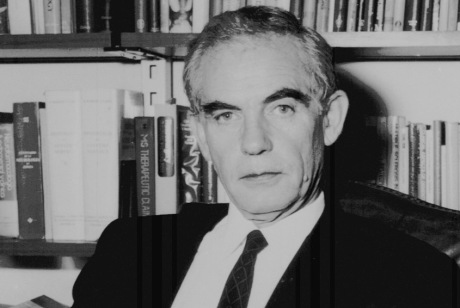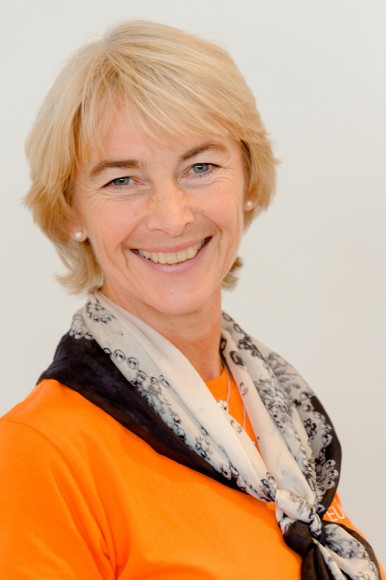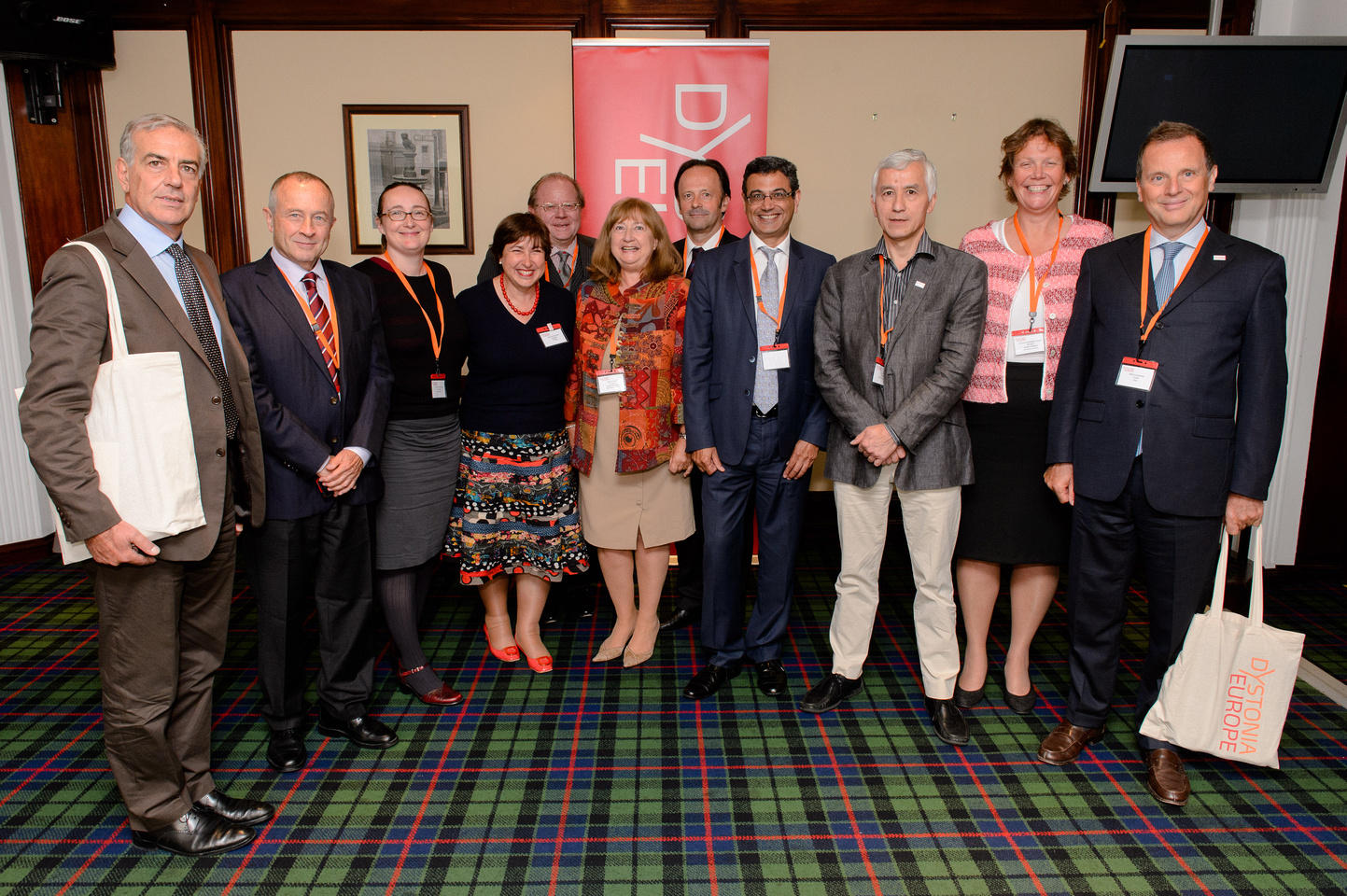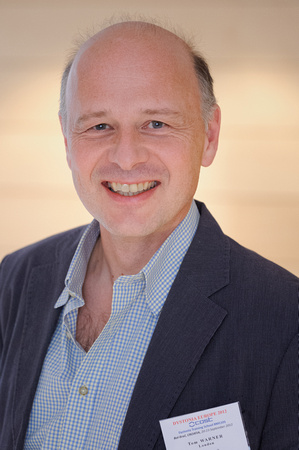How did Dystonia Europe begin, why was it needed, and who are the people and organisations who have contributed over the past 25 years?
THE FORMALITIES
The organisation was formed as an association of national dystonia patient groups in Spoleto, Italy, on 18 June, 1993. The name was European Dystonia Federation (EDF) and the office address was at The Dystonia Society, in London. In 2003, EDF was formally registered in Belgium as an Association International Sans But Lucratif (AISBL) a not-for-profit organisation – and the registered address (‘siege’) at an address in Brussels.

Participants gathering in front of the Parliament.
At the General Assembly in Barcelona on 23 October, 2011, the delegates accepted the Board’s proposals to modernise the organisation and to change the name to Dystonia Europe (DE). The focus of activities also changed, to allow DE to provide a more effective ‘platform’ for partnerships for dystonia with scientists, patient organisations and others. The legal process was completed in 2012, with our registered office remaining in Brussels.
THE WORLD OF PATIENT ADVOCACY IN 1993 Dystonia – unknown to many people
Many people reading this in 2018 might not understand that dystonia wasn’t well-known or well understood twenty-five or thirty years ago. In the1980s and early 1990s, there were still very few specialists with knowledge of dystonia, and diagnosis and treatment were very hard to find in most countries across Europe. We needed to find ways to stimulate interest in dystonia among the younger clinicians and researchers.
Dystonia is a small-scale illness with relatively low numbers of patients – only one of a group of neurological movement disorders, a group which forms only a small section of all neurological illness. Neurology itself, although extremely important in terms of human brain function, forms only a small proportion of the total of all medical conditions – in numbers of patients.
Dystonia prevalence in the context of other illnesses
Many estimates of the total number of human illnesses suggest that there are around 30,000 and some of them have huge numbers of patients across the world. WHO (World Health Organisation) data tells us that there are more than 600 neurological illnesses affecting almost 1 billion people in the world.
Accurate estimates are difficult to calculate because of lack of data – even for the “big” illnesses. For epilepsy, the estimated number of patients is 50 million. For the dementias – 24 million. Parkinson’s disease is estimated to have perhaps 10 million patients. The world figure for dystonia, based on estimates in Europe, would be around 6 million. But there is not enough clear data available on which to base a reliable total number.
Dystonia patient groups in the early 1990s
“Patient advocacy” was just beginning in many areas of health. Very few national dystonia patient groups existed in Europe, and almost all of those were only a few years old. All of these groups started by focussing on the important basic functions of providing contact between patients, good information on the illness and how to find a diagnosis – “patient support”. More advanced ‘advocacy’ was the next step. Representing the interests of patients by providing useful and credible information to healthcare providers and decision makers on what support and treatment patients and their families really need.
The need for partnerships in dystonia
In 1993, it was clear that national dystonia patient organisations in Europe should come together in partnership to learn from one another. They also needed to promote the interests of their members with healthcare decision-makers at all levels, including the European Union. Although, in the EU, healthcare is considered to be an issue for national governments, many decisions are made in Brussels which affect aspects of healthcare in all member states.
The stimulus of some specialists in dystonia – Professors Fahn and Marsden
By the 1980s, the level of knowledge of dystonia was still low among the majority of the broad medical profession. But two specialists in particular began to bring colleagues and young neurologists into their sphere of interest – dystonia.
Stanley Fahn in New York and David Marsden in London had both developed clinical and research interests in dystonia and movement disorders generally. They became good friends and close scientific collaborators on dystonia and other topics. Prof Fahn remains a very senior world figure in movement disorders, and a strong supporter of patient advocacy.

Sadly, Prof Marsden died suddenly at a relatively young age in 1998, but his reputation lives on as a preeminent scientist in his field. His crucial work in establishing dystonia as an organic illness is commemorated by the David Marsden Award. Created by Dystonia Europe in 2003, this Award is presented every two years for the best scientific paper on dystonia from a young scientist.
By the mid 1980s, Profs Fahn, Marsden and others had the idea to form a worldwide scientific organisation to promote Parkinson’s disease, dystonia and other movement disorders. That was the beginning of the Movement Disorder Society, which has grown to be an extremely influential global professional association.
Why did we need to create a pan-European patient organisation in 1993?
- The illness was not well-recognised and diagnosis and treatment were difficult to find .
- Drugs and surgery had been tried by the few dystonia specialists, but with limited success.
- Botulinum toxin was only starting to be used in some European countries in the early/mid 1990s.
- Only a few patient groups existed, they were very new and still trying to establish themselves.
- Many of the national groups focussed on only one type of dystonia (blepharospasm, torticollis, dysphonia, etc).
- We needed to work together as patient advocacy groups and become more ‘professional’ in our activities.
- Clinicians and researchers were working in international partnerships more and more and we needed to create a unified organisation of patients to work with them in a professional way.
- The influence of European Union decisions on national practices was increasing in the field of health.
The Founding of EDF – Spoleto, Italy, 18 June 1993
This process took almost a year, with our first contacts at a workshop in Munich, followed by two preparatory meetings in Barcelona and Paris.
It should be mentioned that, in 1993, international communications were much more basic than they are today. No email. No mobile phones. No Skype. No internet available to the public. Certainly, no Facebook….. We used the telephone, ordinary mail and fax machines. Sending a 10-page fax to 12 or more people in different countries took a long time and was also quite expensive!
THE MANAGEMENT OF THE ORGANISATION OVER 25 YEARS
Board Members and Officers
I was honoured to be elected at the Spoleto meeting as the Founder President and Laura Latini The Founding Committee of European Dystonia Federation in 1993 from Italy became Vice President. Alan Leng, Chief Executive of The Dystonia Society, was appointed as Secretary-General – an unpaid role which he filled with energy and skill until 2001. After a few years, Feli Justo Alonso from Spain followed Laura as Vice President, then Didi Jackson from Germany who later became President and served with enthusiasm, grace and dignity for 6 years in that position, until she retired in 2007. Didi, sadly, passed away quite recently, in February 2018.
Prof Maja Relja
Maja Relja from Croatia, pictured above in Spoleto, became our Vice President in 2012 and has only recently retired from that post. She has been a constant and positive presence for European Dystonia Federation/Dystonia Europe since 1993, and remains a warm and supportive friend as a member of our Medical and Scientific Advisory Board.
Ginger Butler
Ginger was a very warm and larger than life character from the North East of England, with a deep wish to help dystonia patients. He contributed greatly to our Board meetings, as Vice President from 2001 to 2008 and again, as a Board Member, from 2009 until 2012.
Despite having no earlier training in medical science, he gained a PhD based on epidemiology in dystonia and carried out several dystonia research studies before he passed away, sadly and unexpectedly in 2012.
Readjustment of Board responsibilities in 2001
By 2001, it was clear to me that the hugely increased workload of the President could no longer be continued by one person alone, even though I had taken early retirement from my business career some years before. Fundraising, daily financial control, all documentation, website, legal, accounting, publicity, very frequent travel to Brussels and many other countries, all had become impossible to sustain.
A strategy plan was created, to restructure the organisation, employ a part-time Executive Director, and ensure that the Board members took more responsibility for decisions. I had intended to retire completely at that point, but the Board asked me to remain and take the position of Executive Director, to provide continuity. With the new distribution of responsibilities, this was a realistic solution and I retired from the Presidency at the General Assembly in 2001, to become the first Executive Director.
A new beginning for European Dystonia Federation
In 2006, one year before Didi Jackson’s term of office as President would end, there was no obvious successor. Then, at the 2006 General Assembly, we met a new delegate from Sweden, Monika Benson. It was clear from that first meeting that Monika had the personality and capabilities to lead our federation into the next stage of its life, and she eventually agreed to be nominated by the Swedish association. Monika was appointed as our President in 2007.

Many things in the world had changed since 1993 and, after a period of ‘settling in’, Monika began to make differences in our approach to match the new generation of people, organisations and institutions which had developed. We changed the name and ‘image’ from the old blue and white to a much warmer and more modern presentation of colours and messages for Dystonia Europe, on a new website and letterhead.
New activities and projects followed and our members, dystonia clinicians and researchers, partner organisations and our sponsors all responded very positively.
When Monika’s term of office as President ended in 2013, the post of Executive Director was vacant, and she agreed to be appointed to the job, to provide continuity and support the new President, Robert Scholten, from The Netherlands. Robert decided to retire from his post after one term of office, and Merete Avery from Norway was appointed as President in 2015. Merete has already provided great stability and, no doubt, some future historian will comment warmly on her very hard work after her term of office ends!
List of all Board Members and Officers
Many others have served terms as Board members and Officers of DE over the past 25 years. Our organisation is grateful to them all for their time and their energies.
Our Medical and Scientific Advisory Board (MSAB)
A number of specialists from across Europe, who have become senior figures in movement disorders, have been appointed to our MSAB and many of them are pictured above at our 20th Anniversary meeting in Edinburgh in 2013. We are grateful to them all for the support they have given EDF/DE over the past 25 years.

Two MSAB members deserve special mention – Profs Tom Warner and Alberto Albanese

The two neurologists pictured above (who were both young in 1993!) have been especially close to EDF/DE ever since it was founded. Tom Warner was our sole medical adviser for many years, until we appointed a Medical and Scientific Advisory Board. He has contributed many ideas and gently guided us away from many mistakes, with great sensitivity, humour and quiet wisdom.

In the early years, he organised EDF’s first research project – An Epidemiological Study of Dystonia in Europe, under Prof Marsden as the Principal Scientist. He has been involved in many other activities with us since then, and remains a close friend of DE. Our relationship with Alberto Albanese also stretches back to the founding of DE in 1993, and we have collaborated with him on many projects. The most recent, of course, was the European Dystonia Research Network which he chaired during the 4 years funded by the COST (Cooperation in Science and Technology) grant which he obtained in 2011. Dystonia Europe was elected by the scientists to act centrally, as Grantholder and Administrator of the project. The Network not only stimulated collaborative research partnerships, but provided grants to young scientists for short term scientific missions, and grants to attend dystonia training courses which the Network organised. Prof Albanese also remains a good friend of Dystonia Europe.
DEVELOPMENTS IN CLINICAL AND RESEARCH INTEREST IN DYSTONIA
Let’s take a look at how the interest in dystonia by medical professionals has changed over these 25 years.
First, the number of people attending Movement Disorder Society congresses has increased substantially……… from 1280 attendees at their first congress in 1992, to 5,500 attendees in 2016.
European Academy of Neurology (formerly European Federation of Neurological Societies) has developed a strong relationship over many years with MDS. EAN annual congresses increasingly feature dystonia sessions. This year, 2018, several of Dystonia Europe’s Medical and Scientific Advisory Board are speakers in a special session on dystonia and another session features the David Marsden Lecture. This will be presented by the outgoing EAN President, Prof Gunther Deuschl, who is a renowned movement disorder specialist.
We must also mention the 3 excellent conferences on Treatment of Dystonia, which have been organised in Hannover, by 3 more friends and supporters of Dystonia Europe, Profs Eckhart Altenmueller, Joachim Krauss and Dirk Dressler. Conference attendees: 2010 – 250; 2013 – 500+; 2016 – 500+.
Dystonia Europe has also been successful in organising large-scale international scientific conferences, focussed on dystonia. In 2008, we attracted 250+ specialists to our 2-day event in Hamburg and, in 2011, we welcomed around 550 dystonia specialists from 39 countries to the 5th International Dystonia Symposium in Barcelona, with a scientific programme of 50+
speakers. On this occasion, we were delighted to be joined in the organising of the 3-day event by the Dystonia Coalition and Dystonia Medical Research Foundation, both from USA. All previous Symposia in this series have taken place in USA and the 4th Symposium was held in Atlanta in 2002.
PARTNERSHIPS WITH OTHER ORGANISATIONS AT THE EUROPEAN LEVEL
European Federation of Neurological Associations (EFNA) – Founded 1997
European Brain Council (EBC) – Founded 2002
Dystonia Europe was very involved in the founding of both of these organisations, and in their development during the years since then.
EFNA is an ‘umbrella’ group for pan-European neurological federations, such as Dystonia Europe. In fact, a federation of federations! It represents many neurological illnesses and a large scientific organisation like EAN (European Academy of Neurology) which covers all of neurology, finds it easier to work in partnership with an organisation with a similar spread of interest, instead of having separate relationships with individual groups. This same principle of bringing together many different strands of the same area of health also appeals greatly to politicians. EFNA quickly became a very successful initiative, and has developed even more in recent years.
EBC is a high-level scientific organisation which has successfully combined the efforts of pan-European psychiatric and neurological organisations, from both scientific and patient areas and from the pharma and medical device industries. This gives EBC enormous credibility as a lobbying organisation.
EFNA is a founder member of EBC and Dystonia Europe’s representatives have played central roles in both organisations since they were founded.
The main aim of EBC is to clarify the realities of brain illnesses in an ageing population, and to use its credibility to influence the views of the European Institutions. Among a number of importrant research projects, EBC has shown that the societal costs of “Brain Illness” in Europe amount to at least €800 Billion per year. This is a staggering amount of money, but is actually less than the probable real total, as many ‘smaller’ illnesses like dystonia do not have enough research data available to be included in the study.
However, the credibility of EBC and its research is so strong that there has been a very considerable increase in the amount of EU research funding made available for brain illness projects over the past 15 years, and also in the number and value of grants allocated in that area. When EBC was founded, the word “brain” did not appear anywhere in the European Commission’s calls for grant applications to the Framework Programme……. A huge positive change has taken place.
Foundation for Dystonia Research (FDR) – is a private foundation, based in Belgium, which focuses on promoting research in dystonia. In partnership with the Belgian Government, it has co-funded a chair and a department in the University of Leuven, headed by Professor Rose Goodchild, who is a member of Dystonia Europe’s Medical and Scientific Advisory Board. The Foundation has also given strong support to DE for the 5th International Dystonia Symposium, Barcelona 2011.
Partnerships with the industry
Five companies have given us tremendous sponsorship support, some of them over many years. Allergan, in particular, provided crucial support right at the start and for the first few years, when no other companies were in the dystonia ‘market’ in Europe. In more recent years, our partnerships with Ipsen, Medtronic, Merz and Boston Scientific have developed very successfully, and DE enjoys good, transparent relationships with the industry, and without conflicts of interest.
SO – WE HAVE ARRIVED IN 2018! HOW DID WE GET HERE?
Here is a contrast between Spoleto in 1993 and today’s Dystonia Europe! A much more lively photograph in Croatia, a few years ago. But didn’t we all look very young in 1993!
These two photographs, I think, show how European Dystonia Federation and Dystonia Europe have developed, to keep up with scientific and societal change in the dystonia community and its needs. Our organisation has initiated and supported many worthwhile projects, which have contributed to improving the lives of dystonia patients. That provides an excellent platform for more developments in the future and, on behalf of Dystonia Europe, I thank all the fine people – patients and their families, medical and healthcare professionals, industry and other supporters and many other people who have contributed so much to that work over the past 25 years.
Alistair Newton
June 2018
